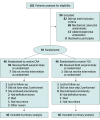Long-Term Results of 2-Stage Turnbull-Cutait Pull-Through Coloanal Anastomosis for Low Rectal Cancer: A Randomized Clinical Trial
- PMID: 38985480
- PMCID: PMC11238068
- DOI: 10.1001/jamasurg.2024.2262
Long-Term Results of 2-Stage Turnbull-Cutait Pull-Through Coloanal Anastomosis for Low Rectal Cancer: A Randomized Clinical Trial
Abstract
Importance: In patients operated on for low rectal cancer, 2-stage Turnbull-Cutait pull-through hand-sewn coloanal anastomosis provides benefits in terms of postoperative morbidity compared with standard hand-sewn coloanal anastomosis associated with diverting ileostomy and further ileostomy reversal.
Objective: To compare long-term results of these 2 techniques after ultralow rectal resection for rectal cancer.
Design, setting, and participants: In this randomized multicenter clinical trial, neither patients nor surgeons were blinded for technique. Patients were recruited in 3 centers. Patients undergoing ultralow anterior rectal resection needing hand-sewn coloanal anastomosis were randomly assigned to 2-stage Turnbull-Cutait pull-through hand-sewn coloanal anastomosis (n = 46) or standard hand-sewn coloanal anastomosis associated with diverting ileostomy (n = 46).
Interventions: All patients underwent ultralow anterior resection. Patients assigned to the 2-stage Turnbull-Cutait pull-through group underwent exteriorization of a segment of left colon through the anal canal. After 6 to 10 days, the exteriorized colon was resected and a delayed hand-sewn coloanal anastomosis performed. For patients assigned to standard coloanal anastomosis, the hand-sewn coloanal anastomosis was performed with diverting ileostomy during the first operation. Ileostomy closure was scheduled after adjuvant treatment was completed in about 6 to 8 months.
Main outcome and measure: The study aimed to compare the differences between the 2 groups in terms of long-term surgery-related morbidity, functional, and oncological outcomes at 3 years postoperatively. Data were analyzed from October 1, 2018, through October 31, 2021.
Results: The 92 patients randomized in the first study were included for the 3-year follow-up. The overall morbidity rate in the 2 groups showed that 15 patients (16.3%) had complications with a difference of 6.52 (95% CI, -8.93 to 21.79). Nine patients (19.6%) and 6 patients (13.0%) in the 2-stage Turnbull-Cutait pull-through group and hand-sewn coloanal anastomosis group, respectively, had complications without statistically significant differences (P = .57). Oncological results were comparable between the groups. Long-term fecal continence in the CCA and TCA groups, respectively, assessed using the Wexner Incontinence Score was 10.9 (5.50-15.5) vs 13.0 (7.25-16.0; P = .92), Low Anterior Resection Syndrome score was 32.0 (21.0-37.0) vs 34.0 (23.2-38.5; P = .76), and Colorectal Functional Outcome score was 38.5 (23.0-47.1) vs 40.8 (23.3-58.2; P = .30).
Conclusions and relevance: In this study, after a 3-year follow-up period, 2-stage Turnbull-Cutait anastomosis for ultralow rectal cancer could be considered as a surgical alternative that has the valuable benefit of avoiding a temporary stoma with similar results in terms of morbidity, fecal continence, patient satisfaction, quality of life, and oncological outcomes when compared with hand-sewn coloanal anastomosis with ileostomy.
Trial registration: ClinicalTrials.gov Identifier: NCT01766661.
Conflict of interest statement
Comment on
-
Construction of a Coloanal Anastomosis vs Closure of a Diverting Ileostomy.JAMA Surg. 2024 Sep 1;159(9):996-997. doi: 10.1001/jamasurg.2024.2234. JAMA Surg. 2024. PMID: 38985497 No abstract available.
References
Publication types
MeSH terms
Associated data
LinkOut - more resources
Full Text Sources
Medical


